Exploring Oak Veneer in Home Design: Insights from Home Depot
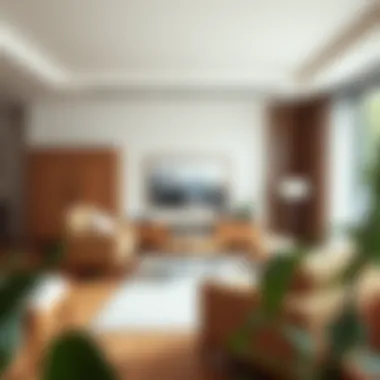

Intro
In the realm of home design, oak veneer emerges as a notable contender, praised for its distinctive characteristics and versatility. While many materials vie for attention, oak veneer holds a special appeal for homeowners and designers alike. This material, thinner than solid oak, opens up avenues for creativity and style without the hefty price tag associated with solid wood. The intention behind this article is to delve into the practical implications of using oak veneer, including the insights gathered from Home Depot’s extensive offerings, which serve as invaluable resources for anyone looking to enhance their living environments.
The choice of materials plays a pivotal role in the aesthetic and functional aspects of home design. In this article, we will navigate the nuances of oak veneer, addressing its advantages, disadvantages, and various applications. From the latest furniture design trends to practical tips for selecting the right pieces, we've got you covered. It's essential to gather all the relevant details to make informed decisions that reflect personal style and practicality.
Let’s embark on this exploration of oak veneer, discovering how it can contribute to both functional and stylish home design.
Intro to Oak Veneer
When exploring the landscape of home design, it’s easy to overlook the materials that quietly enhance both functionality and aesthetics. Oak veneer stands tall as one of those unsung heroes, offering a multitude of benefits for interiors. It garners attention not just because of its traditional roots, but due to its modern applications that resonate well with contemporary tastes. The rich texture and warm tones of oak veneer lend an organic feel to any space, making it a sound choice for interior designers and homeowners alike.
Definition and Composition
Oak veneer is a thin layer of oak wood, meticulously sliced from a larger piece of solid wood. Generally thinner than 3mm, this veneer showcases the distinctive characteristics of oak while consuming fewer resources than traditional solid wood. Often, it’s adhered to substrates like plywood or particle board, allowing for both durability and cost-effectiveness. This composition means you get the luxurious appeal of oak without breaking the bank.
Veneer layers can vary in thickness, but the beauty lies in the depth of grain and the ability to stain or finish it in various shades. Home Depot offers a wide array of options, catering to varied project styles and aesthetic preferences. It’s like having the best of both worlds—rich visual appeal and practical use.
Historical Context
The use of oak in furnishings dates back centuries. From medieval castles to modern homes, oak has been revered for its robustness and beauty. Historically, craftsmen recognized oak as a prime material due to its natural strength and resistance to wear. As time progressed, oak veneer became a viable alternative, especially during periods when environmental sustainability began to surface as a concern in construction practices.
In the mid-20th century, as furniture design evolved, so did the methods of using wood. The development of modern veneer technology allowed artisans to create intricate designs that showcased the versatility of oak. Today, oak veneer is not merely a throwback to traditional craftsmanship; it embodies a fusion of time-honored techniques and innovative design approaches.
Through history, oak veneer has navigated from being a luxury to an accessible choice for many homeowners. Its enduring appeal in home design reflects its ability to adapt, much like the trees from which it comes.
As we continue to explore the realm of oak veneer throughout this article, it becomes apparent that this material is more than just wood; it’s a testament to style, sustainability, and smart home design.
Properties of Oak Veneer
When considering materials for home design, the properties of oak veneer hold significant importance. Not only do these properties influence the overall aesthetics of a space, but they also determine durability, maintenance, and environmental impact. Homeowners and designers alike appreciate oak veneer for its unique blend of strength and beauty, making it a popular choice in modern interior projects.
Durability and Strength
Oak veneer, though a thin layer of wood, doesn't shy away from toughness. This material boasts impressive durability that rivals solid wood in many respects. While it might not be as resilient to heavy impacts as its solid counterpart, it withstands everyday wear and tear remarkably well. A major benefit here is that oak veneer products, typically bonded to a composite core, can resist cracking and warping better than standalone wooden pieces in humid environments.
Additionally, using oak veneer can provide structural integrity to furniture, ensuring that items like cabinets and tables not only look good but also maintain their shape over time. Importantly, when buying from trusted sources such as Home Depot, purchasers can be more confident in their selection, as quality control in production ensures a reliable product.
Aesthetic Appeal
One cannot discuss oak veneer without mentioning its aesthetic appeal. It enhances interiors with a richness that captures the eye. The beauty of oak veneer can be attributed to two key aspects: color variations and grain patterns.
Color Variations
The color variations in oak veneer are striking. From warm honey tones to deeper chestnut shades, homeowners can find the perfect hue to complement their existing decor. This rich palette allows for excellent matching with other wood furnishings or even different materials, making oak veneer a versatile choice.
One of the standout characteristics is its ability to adapt under different lighting conditions. Natural light can enhance the warm tones, making a room feel cozy and inviting. In contrast, artificial light can bring out its deeper, more luxurious shades, elevating the space's overall ambiance. This adaptability plays a significant role in why oak veneer remains a fashionable choice in home design.
Grain Patterns
Equally important to color are grain patterns. Oak veneer features beautiful, distinct grains that can transform a standard surface into a focal point. The swirling, wavy patterns in oak provide a depth that can add character to furniture pieces from sleek modern designs to rustic traditional styles.
The unique feature of these grain patterns lies in their randomness; no two pieces of oak veneer are alike. This individuality makes each piece feel special and tailored, appealing to homeowners who value authenticity in their design choices. However, one factor to consider is that bold grain patterns may not suit every decor style. Some may find them overwhelming in simpler designs, thus a careful balance is needed.
Environmental Impact
In today's world, environmental considerations are vital in choosing materials. Oak veneer, when sourced responsibly, can have a relatively low environmental impact. Unlike solid wood, which often necessitates harvesting entire trees, veneer processes use only a thin layer of wood, allowing the rest of the tree to continue thriving. This can promote sustainable forestry practices, especially when purchasing from retailers like Home Depot that prioritize eco-friendly materials.
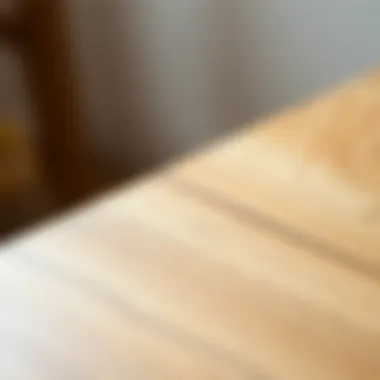
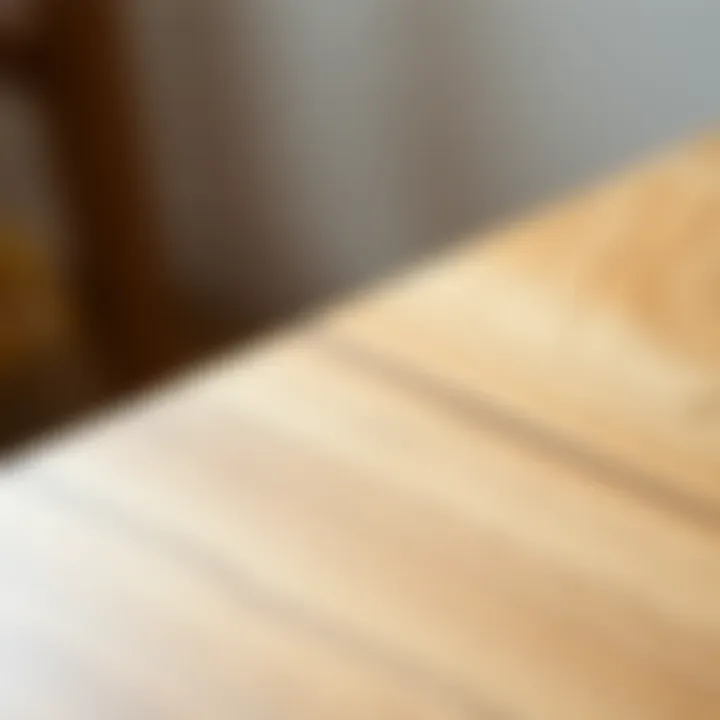
Moreover, many manufacturers are employing techniques to minimize waste during production. This sustainable approach enhances the environmental credentials of oak veneer, making it a more desirable choice for conscientious homeowners and designers looking to create beautiful spaces without sacrificing their ethical responsibilities.
"When you choose oak veneer, you’re not just selecting a material; you're making a statement about your design values and priorities."
Advantages of Using Oak Veneer
The growing trend in home design often leads people to consider various materials for their interiors. Oak veneer stands out for several reasons, appealing notably for its unique blend of attributes. Whether one is looking to refresh an old space or start from scratch, understanding the advantages of using oak veneer becomes vital.
Cost-Effectiveness
One of the most enticing aspects of oak veneer is its cost-effectiveness. Solid oak furniture can leave a significant dent in the wallet, but oak veneer provides a desirable alternative that manages to replicate the same warm aesthetic. The process of creating veneer utilizes a thin layer of quality oak over a less expensive core material, resulting in a high-value piece without the high price tag.
For budget-conscious homeowners and designers, this affordability does not compromise beauty or functionality. In practical terms, instead of investing thousands in solid oak tables or cabinetry, one can opt for oak veneer options that still capture the elegance and durability of oak. For example, consider a pristine oak veneer cabinet, which can often cost less than half the price of a solid oak counterpart, without sacrificing the rich texture and visual appeal.
Ease of Maintenance
Maintaining wood finishes isn’t always a walk in the park, but oak veneer earns its stripes when it comes to hassle-free upkeep. Unlike solid wood, which may require extensive polishing and sealing to maintain its appearance, oak veneer just needs regular dusting and gentle cleaning with a damp cloth. This simplification holds particular weight for busy families or those with active lifestyles, allowing them to enjoy the beauty of natural wood without the constant worry.
In addition, many modern oak veneer products come with protective coatings that enhance durability against daily wear and tear, thus prolonging their lifespan. Generally, avoiding harsh chemicals is advised, ensuring that the silky finish retains its luster for years to come.
Versatility in Design
The versatility of oak veneer is often touted as one of its significant advantages. With its vast color variations and grain patterns, designers have the freedom to explore diverse styles. From contemporary to rustic aesthetics, oak veneer fits seamlessly into almost any design scheme, making it a favorite among interior decorators.
- Color Variations: Oak veneer can be stained in various shades, from rich dark browns to lighter, airy tones. This adaptability allows it to blend into various color palettes perfectly.
- Grain Patterns: The grains of oak veneer can tell a story; from broad swirls to tight lines, these patterns lend a unique character to each piece. This adds interests and sophistication to furniture, ensuring one does not get stuck with a cookie-cutter look.
Indeed, whether it's a sleek modern desk or a charming cabinet, oak veneer has the ability to adapt to differing design needs, proving its place in both contemporary homes and traditional spaces.
"The beauty of oak veneer lies not only in its appearance but also in its practicality, making it a selection worthy of consideration for designers and homeowners alike."
In summary, the advantages of using oak veneer extend far beyond just aesthetics; they speak to functionality, cost, and adaptability. As we continue this exploration, it’s essential to remain aware of both the benefits and challenges that come with this material to make well-informed design choices.
Challenges Associated with Oak Veneer
When diving into the world of oak veneer, it becomes clear that, while it carries a certain charm and aesthetic appeal, it’s not without its shortcomings. Each material has its pros and cons, and oak veneer is no exception. Understanding the challenges associated with oak veneer is crucial for homeowners, interior designers, and anyone looking to enrich their living spaces. These insights help guide decisions, ensuring that the benefits outweigh any potential drawbacks. Let us look closely at some key challenges that might come up when working with this material.
Potential for Scratches and Damage
Although oak veneer is more durable than many other veneer species, it can still fall victim to scratches, dents, or damage. It's somewhat akin to that lovely pair of leather shoes you meticulously care for; they can take a beating but aren’t entirely impervious to scuffs and wear.
Oak veneer can be susceptible to marks from everyday items such as keys, furniture, or even pet claws. Over time, these scratches can accumulate, leading to a less-than-ideal appearance. In high-traffic areas, especially, it’s important to consider protective measures such as rugs, felt pads, or even avoiding dragging furniture across the surface.
"The beauty of oak veneer lies in its natural charm, but care is essential to keep it looking sharp and refined."
Moisture Sensitivity
Oak veneer tends to play a game of hide and seek with moisture, sometimes hiding the real risks it poses to its longevity. Unlike solid wood, which can withstand some dampness, veneer is thin and doesn’t fare well in humid or wet conditions. If water finds its way beneath the surface, it can warp or cause delamination, leading to repairs that may be beyond simple fixes.
Consider areas such as kitchens or bathrooms, where water is often present. Using oak veneer in such places could lead to what some folks call a "ticking time bomb" scenario — it looks great at first, but problems can arise down the line if not managed well. Regular sealing and using coasters for wet items can mitigate some of these risks.
Limited Longevity Compared to Solid Wood
A home built with solid wood stands as a testament to durability and timeless elegance, often becoming a family heirloom. Oak veneer, on the other hand, may not last as long due to its construction. Essentially, it’s like comparing a shiny new car to a rugged old truck — both have their merits, but the truck is likely going to endure the test of time.
The thin layer of oak veneer means that it can only be sanded and refinished a handful of times before it wears down to the substrate. This limitation can be particularly frustrating for those who value longevity in their home furnishings. While oak veneer provides a beautiful surface finish, it’s essential to remember that solid wood offers a longer lifespan and more opportunities for repair.
Comparative Analysis with Other Materials
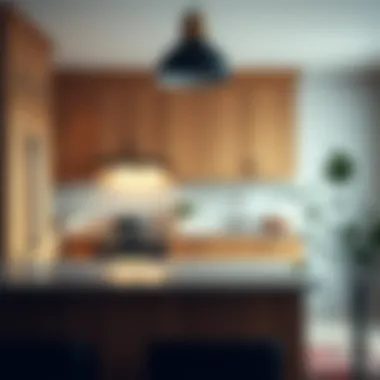
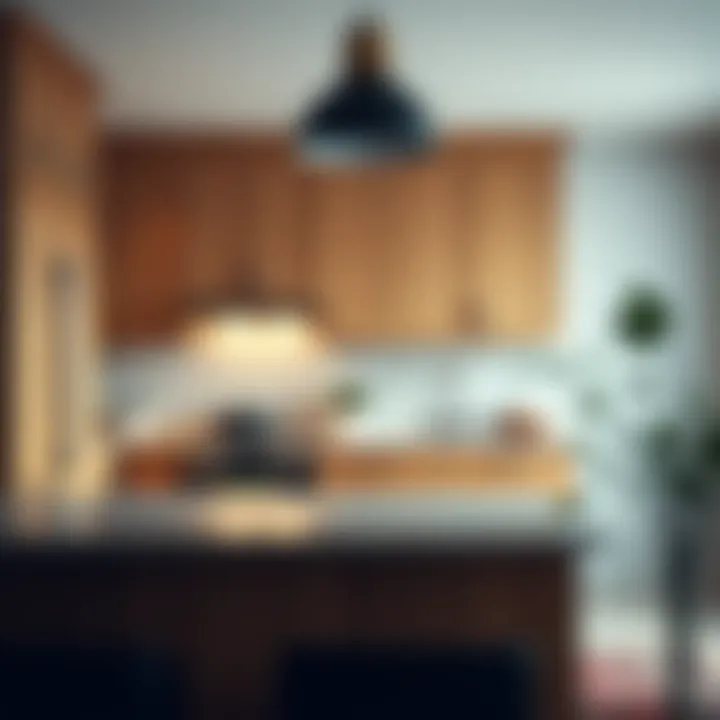
When considering oak veneer in home design, t's essential to put it side by side with other materials. This comparative analysis serves many purposes; it not only highlights the unique characteristics of oak veneer but also guides homeowners and designers in making informed choices based on their specific needs, aesthetics, and budgets. It spills the beans on how oak veneer stacks up against solid wood, laminate, and even eco-friendly alternatives. Each of these comparisons reveals strengths and weaknesses, ultimately creating a roadmap for decision-making in home design.
Oak Veneer vs. Solid Wood
The age-old debate of oak veneer versus solid wood often crops up among those who value quality and aesthetics alike. Solid wood has its charm—there's something undeniably authentic about its heft and texture. It is robust and can last for generations if cared for properly. However, the price tag for solid oak can be quite daunting. Oak veneer, on the other hand, offers a similar visual appeal at a fraction of the cost. It consists of a thin layer of real oak atop a sturdy core material. This results in a look that's genuine without denting the wallet too much.
- Cost: Solid wood is typically more expensive, making oak veneer a more budget-friendly option.
- Weight: Solid wood is heavier, which can be cumbersome in furniture design, whereas oak veneer is lighter, aiding in mobility and installation.
- Durability: While solid wood can be repaired and refinished, oak veneer is more susceptible to moisture and scratches, requiring cautious handling.
- Sustainability: With the right choices, oak veneer can be sourced from sustainable environments, whereas the harvesting of solid wood often raises concerns.
Practical Applications in Furniture
The appeal of oak veneer in home design goes far beyond aesthetics; it serves a functional role in furniture manufacturing that many homeowners and designers appreciate. Its adaptability allows for a wide range of furniture styles, from traditional to modern, making it a favored choice for versatile spaces. Understanding the specific applications of oak veneer in furniture can help consumers make informed choices that suit their personal tastes and living environments.
Cabinets and Cupboards
Cabinets are the backbone of any kitchen or storage area, and using oak veneer can significantly boost their design. The natural grain patterns found in oak veneer lend a touch of sophistication to cabinets, whether they're standing proud in a kitchen or tucked away in a hallway. A primary factor to consider here is the weight and size of the materials; oak veneer is lightweight compared to solid wood, making it easier to install and maneuver.
Additionally, oak veneer cabinets are often favored for their cost-effectiveness. While solid wood can be a wallet-buster, oak veneer offers a similar visual appeal without breaking the bank. They can be easily customized with various stains and finishes, allowing for a personalized touch in any home. Just remember, they may require some additional care to maintain their pristine look, especially in high-traffic areas.
Tables and Desks
When discussing tables and desks made of oak veneer, versatility takes center stage. From dining tables that can serve multiple purposes to desks that cater to home offices, the application of this material is truly vast. Oak veneer tables tend to strike a balance between elegance and practicality. For instance, an oak veneer dining table can act as a gathering spot for family and friends, while doubling as a workspace for school projects or crafts.
One advantage of using oak veneer in tables and desks is the ease of matching it with other materials. Oak veneer works exceptionally well with metal or glass components, creating a striking contrast. However, it's crucial to note that while oak veneer provides beautiful surfaces, excessive moisture can be a foe. Protecting the finish with coasters and avoiding direct water exposure will preserve that inviting look.
Decorative Elements
Decorative elements made of oak veneer could range from wall panels to decorative trays, offering an opportunity to incorporate this wood in various subtle yet impactful ways. Using oak veneer for accents can tie a room together, giving it cohesion while showcasing the natural beauty of the wood grain. For example, a wall panel created from oak veneer can transform an otherwise bland wall into a focal point, drawing in the eyes and setting the tone for the surrounding decor.
Furthermore, smaller items, like decorative trays or framed artwork featuring oak veneer, can serve as exquisite conversational pieces. They give homeowners a chance to express their personality in their decorating style while serving practical functions.
"When it comes to furnishing a home, oak veneer offers a blend of beauty and functionality that truly stands out."
In sum, oak veneer is not just a pretty face in the world of home design. Its practical applications in furniture—from cabinets and tables to decorative elements—illustrate its importance as a versatile material that can enhance both functionality and aesthetics in a home.
Maintenance Tips for Oak Veneer
Taking proper care of oak veneer is crucial for maintaining its beauty and extending its lifespan. This section sheds light on essential maintenance tips that can help homeowners and designers alike keep their wooden avenues looking fresh and inviting. Regular upkeep not only preserves the natural charm of oak veneer but also enhances its durability against wear and tear.
Cleaning Regimens
Keeping oak veneer clean is the first step in its maintenance. Dust and grime can accumulate and dull the finish, so a thoughtful cleaning routine is necessary. Here are some effective strategies for cleaning:
- Use a Soft Cloth: Start with a soft, lint-free cloth for routine dusting. Microfiber cloths work wonders—just a light swipe is usually enough.
- Damp Cleaning: For more stubborn dirt, dampen your cloth slightly with water. Avoid soaking the veneer as excess moisture can seep in and cause damage.
- Mild Detergent: Occasionally, using a solution of mild dish soap mixed with warm water can help. Just ensure the cloth is barely wet and always dry the surface afterward.
Keeping oak veneer clean is akin to giving it a breath of fresh air; it maintains its life and looks.
Having a regimented cleaning schedule is recommended. Regularly wiping down surfaces—once a week or so—can keep dust at bay and prevent buildup. Avoid using harsh chemicals or abrasive cleaners, as these can mar the surface finish.
Protective Measures
Taking precautions can have a significant impact on how well oak veneer withstands the test of time. Here are some measures to consider:
- Coasters and Mats: Always use coasters under drinks, and place mats under decor items. This prevents rings and scratches from forming on the surface.
- Furniture Polish: Using a high-quality furniture polish can not only enhance the shine, but it also provides a layer of protection against everyday spills.
- Humidity Control: Maintain a stable humidity level in your home to avoid warping. Too much moisture can swell the veneer, while excessive dryness can lead it to crack.
- Avoid Direct Sunlight: Position furniture strategically to avoid prolonged exposure to sunlight, which can fade the color and damage the finish.
These protective steps ensure that oak veneer retains its aesthetic appeal and functionality for many years.
By implementing these maintenance tips, you can enjoy the elegance and charm of oak veneer while also safeguarding your investment in home design.
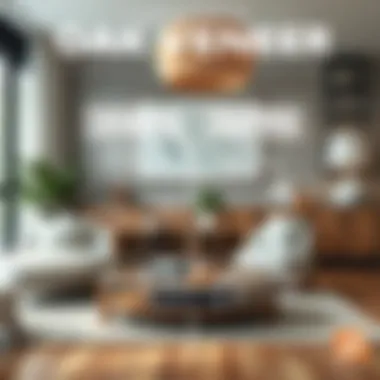
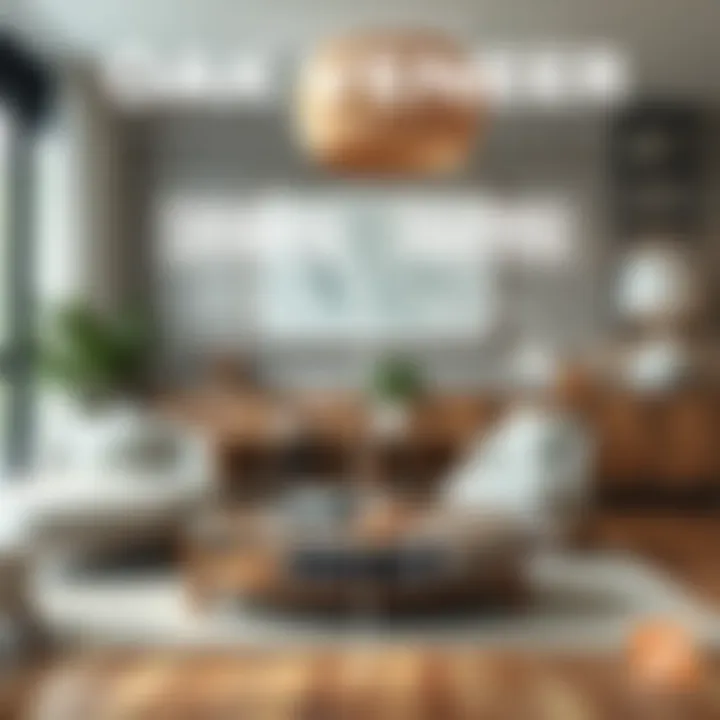
Cost Considerations
When diving into home design, understanding expense categories is crucial. The choice of materials influences not only the upfront costs but also the long-term value and satisfaction derived from a project. Oak veneer, with its unique positioning in the market, offers various advantages coupled with specific financial implications that homeowners and designers must consider.
Pricing Trends at Home Depot
Over the past few years, pricing trends for oak veneer at Home Depot have shown a stable increase, reflecting its growing popularity among homeowners and contractors alike. Typically, the cost of oak veneer can fluctuate based on several factors:
- Quality of Veneer: High-grade oak veneer can command a higher price due to its durability and aesthetic appeal.
- Thickness and Size: Thicker, larger sheets tend to be more expensive, as the production costs are higher.
- Market Demand: As more people look for sustainable, visually appealing options, the demand for quality oak veneer has increased, pushing prices upward.
In 2023, customers can expect to pay roughly $30 to $60 per sheet of oak veneer, depending on the aforementioned factors. This pricing places oak veneer somewhere in the mid-range compared to alternatives like laminate, which may be less expensive but offers different qualities.
Budgeting for Projects
When planning to incorporate oak veneer into design projects, creating a realistic budget is essential. Here are some important considerations for homeowners and designers alike:
- Assess the Scope of Work: Before embarking on a renovation or furniture project, it’s beneficial to outline areas where oak veneer will be used. Will it be for cabinetry, a dining table, or perhaps both? Knowing the full scope helps to avoid unexpected costs.
- Include All Costs: Aside from the direct purchase price of oak veneer, other costs may include:
- Factor in Long-term Costs: While oak veneer may provide initial savings compared to solid wood, thinking of environmental impacts and longevity is crucial. The durability of oak veneer means it can last many years, potentially saving costs on replacements or repairs in the long run.
- Look for Discounts and Promotions: Home Depot regularly updates its pricing and often runs promotions. Keeping an eye on sales can lead to significant savings. Moreover, consider purchasing multiple sheets at once to leverage bulk pricing.
- Installation Fees: Hiring a professional may incur additional charges.
- Finishing Materials: Stains, sealants, or other finishing products add to the budget.
- Tools and Equipment: If taking the DIY route, some tools may need to be bought or rented.
Creating an itemized budget can make the process smoother and keep surprises at bay. With careful planning, oak veneer can be an attractive option that blends aesthetics with cost effectiveness in any home design venture.
User Reviews and Experiences
Understanding user reviews and experiences is key when considering any material for home design, particularly oak veneer. They provide a window into how this material performs in real-world applications, shedding light on aspects that may not be covered by manufacturers or salespeople. Home Depot, being a trusted source for many homeowners and designers, often features numerous insights and evaluations from a diverse array of users. Examining these perspectives can help potential buyers make more informed decisions by highlighting both the advantages and challenges associated with oak veneer.
Positive Feedback
When diving into the realm of positive feedback, several recurring themes arise among users regarding oak veneer. One notable aspect is its visual appeal. Many consumers rave about the rich colors and distinctive hues of oak veneer, which can vary from light tan to deeper shades with warm undertones. Users appreciate how it adds a touch of elegance and warmth to their spaces.
In the realm of functionality, the ease of installation is another frequent highlight. Homeowners have shared stories of how they tackled DIY projects effortlessly, using oak veneer to craft cabinets or accent pieces without needing to hire professionals.
Furthermore, users often mention the cost-effectiveness of oak veneer when compared to solid wood. This point resonates particularly with budget-conscious individuals who seek the aesthetic qualities of wood without breaking the bank. For many, particularly first-time home buyers or those redecorating on a limited budget, using oak veneer translates into greater value.
"I bought a vanity with oak veneer at Home Depot, and it looks absolutely stunning! Easily the best restoration project I did this year."
Common Complaints
On the flip side, it is important to address the common complaints that some users express regarding oak veneer. Though widely praised, potential sensitivity to moisture often emerges as a challenge. Homeowners have pointed out that while oak veneer can look fantastic, it might warp or bubble when exposed to excessive humidity or spills if not properly sealed. Users recommend considering areas like kitchens or bathrooms with higher moisture levels carefully.
Scratch vulnerability is another concern. Several reviewers have noted that oak veneer surfaces can be marked more easily than expected. While it offers a sophisticated look, many users suggest taking proactive measures or using place mats and coasters to protect surfaces from scratches and everyday wear.
Finally, some individuals express dissatisfaction with the limited lifespan when compared to solid wood. Although many appreciate the initial sturdiness of oak veneer, they lament that it doesn't always hold up over time in high-use areas, necessitating repair or replacement sooner than anticipated.
Overall, while positive reviews often highlight its beauty and affordability, it’s crucial to weigh these against the potential drawbacks. This balanced perspective ultimately aids consumers in making decisions suited to their personal needs and style preferences.
The End
Exploring the world of oak veneer in home design has its own unique appeal. In this article, we've examined multiple aspects that showcase this material's versatility and practicality. Whether you are an interior designer or a homeowner, understanding oak veneer’s characteristics, its advantages, and challenges associated with it can lead to informed decisions that enhance aesthetic and functional values in a living space.
Summary of Findings
In our journey, we discovered several key points regarding oak veneer:
- Durability: Oak veneer, while not as robust as solid wood, holds considerable strength for various applications. It withstands daily wear and tear, making it suitable for furniture and cabinetry.
- Aesthetic Value: The myriad of colors and grains found in oak veneer complements a wide range of design styles, from rustic to contemporary. Home Depot offers an extensive selection that can meet diverse tastes.
- Cost-Effectiveness: For those on a budget, oak veneer stands as a solid alternative to solid wood due to its lower price point while still imparting a luxurious look.
- Maintenance: Cleaning and upkeep are relatively simple; knowing the right methods ensures the longevity of oak veneer products.
- User Experiences: Feedback illustrates that users value the beauty of oak veneer but often express concerns about scratches and moisture sensitivity.
These findings are significant for anyone looking to harness the potential of oak veneer in their home designs.
Future Considerations
When considering oak veneer for future projects, several elements deserve attention:
- Innovation in Design: Embrace the evolving trends in home decor that incorporate mixed materials. Oak veneer can be combined with metal or glass to create striking contrasts.
- Sustainability: As environmental factors take center stage in design choices, selecting sustainably sourced oak veneer becomes crucial. Producers should ensure compliance with responsible forestry to mitigate ecological footprints.
- Technological Advances: Advancements in manufacturing may improve durability characteristics. Keep an eye on innovations that enhance resistance to wear and moisture, potentially expanding the application range for oak veneer.
- Educational Resources: Dive deeper into understanding oak veneer by accessing online resources like Wikipedia and Britannica.
By taking these considerations into account, designers and homeowners alike can cultivate an environment that not only looks good but also stands the test of time.



